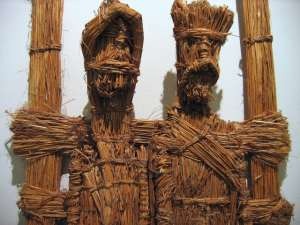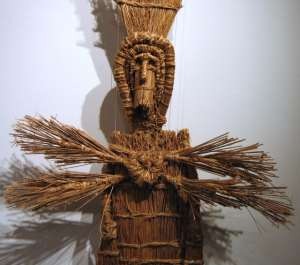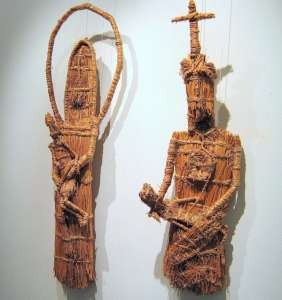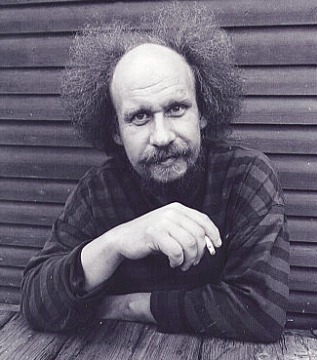MYSTERIOUS WORLD OF MASTER OF FLAXEN SCULPTURES IN ALBUM AND EXHIBITION 0
Romas Daugirdas
www.kamane.lt , 2009 11 12
Photo by R.Daugirdas
In brief: The album of Gintautas Gavenavičius (1960-2004) called “Lino Mūka“ (“Flaxen Mysteries”) was presented at Vilnius Akademija gallery this week. The fact that it was published by the publishing house of Vilnius Academy of Arts is like the last confirmation after the artist’s death that his works are not free-time games with plants or products of a craftsman who knows the subtleties of creation of palms, but a more serious occupation. This fact is also testified by the retrospective of the artist’s works opened at the same gallery on the occasion of the book presentation.
“The sculptures of Gintautas Gavenavičius may be associated with works of Lionginas Šepka. Both artists search for expression of plastic structures in ascetic form prompted by the nature of the material," Zita Žemaitytė wrote in 1989. She was the first professional art critic who turned attention to the works of this artist.
Five years later the art critic Alfonsas Andriuškevičius legitimized the presence of G.Gavenavičius in the field of contemporary art rather than folk art by his small text. After his article was published in the culture weekly Šiaurės Atėnai, the doors opened to the artist to such prestigious exhibition halls as Vilnius Contemporary Art Centre or Kaunas Picture Gallery.
According to A.Andriuškevičius, “G.Gavenavičius continues the tradition of creating god sculptures and starts from their status in which they were left “by the time sharpening its teeth against their bodies”. The bundles of flax or other herbs, which are used for the artist’s works, really reminds of the surface of wooden god sculptures devoured by rain, wind and dust.
G.Gavenavičius knew wood well as he had acquired the specialty of wood carver at Kaunas Stepas Žukas Applied Art Technical School. Still, wood was not his material. He created the first palm as a gift to his godmother. Later he created another palm, birds, a garden. “The more I worked, the more ideas I had. I did not touch wood again. I chose herbs and plants,” the artist said.
The traditional plot of “flaxen pain” is the death of a plant and its rebirth in another shape: thread or canvas. It is often heard in Lithuanian tales, songs or games. G.Gavenavičius was most probably the first Lithuanian artist who combined several meanings of the barbarism popular in Lithuania “mūka” (borrowed from a Russian word – pain, torture, misery). The figure of the crucifix was also often called “mūka”. The works of the artist created on religious themes – stations of the Cross, sculptures of Jesus Christ, Virgin Mary or the saints show the apparent level of folk Catholicism testifying the continuity of tradition more than personal belief. The sculptor did not reject pagan heritage too: Thunder, grass-snake and various gods replenish the view of the world constructed by him perfectly.
Researchers call the works of non-treaded flax created by G.Gavenavičius the top of his creation. Still, a rather devious road led towards these sculptures as G.Gavenavičius was a person interested in many art fields. He created poems, was interested in theatre, pantomime. He attended the pantomime studio of Kęstutis Adomaitis in Kaunas.
After he stared creating plant sculptures, he became fond of birds. The serious friendship with his future wife architect Marija started from birds too. The architect became enchanted by the mysterious flaxen gods in the workshop of the artist in K.Donelaičio Street. She admires them until now, and this is why she did not sell the creative heritage of the artist, who died five years ago. She is organising exhibitions of her husband and has finally fulfilled the biggest dream – to publish the album. It is very “academic" and perhaps even too serious.
There are many articles about creation in it (in addition to the aforementioned ones, articles by the art critic Ieva Pleikienė, sculptor Valentinas Antanavičius, poet Algirdas Patackas); still, there are not many details about the daily life of the artist. It is not even noted that many people knew him as Rišaras rather than Gintautas. The nickname was given to the artist due to the hairdo that reminded of the famous French actor.
Flax is an elastic but rough material, which used to injure hands frequently. After making a flaxen cross for the first time, the artist felt some warmth spreading from it. Even though this fact scared the sculptor more than gladdened him, he could not leave flax already. “Flax is a godly material”, he used to say.
According to the wife Marija, after finishing some work, Gintautas used to become light as if he gave something away from himself to a new sculpture. This strange life is clearly felt in the last works of the artist created when he was ill already. These are chamber works tied up neatly, with many tiny details.
By the way, herbal sculptures are a big challenge to photographers and publishers of the album. When trying to show the general view of bigger works, important small details disappear. Works that are illuminated too well lose roughness of facture, and a sculpture turns into a graphic work.
This is why several photographs created by the photographer of the publication Arūnas Baltėnas in the usual space, home interior, are so important for the album. The artist, who was born and grew up in Kaunas, lived in a homestead near Ukmergė from the year 1987.
G. Gavenavičius. Photo from the archive of Kamane.lt













